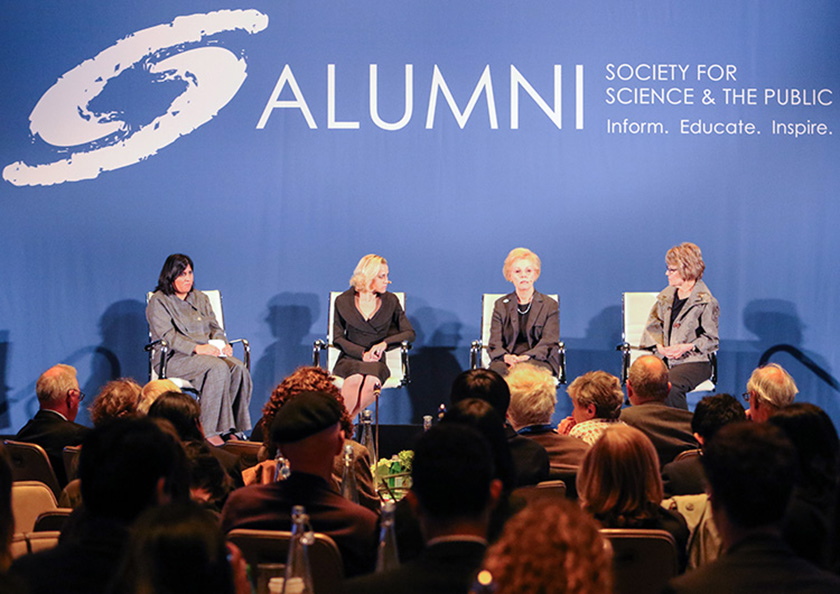Earning the right to be a science leader

“Our nation is changing,” said Mary Sue Coleman. “We need to shift to opening science up to underrepresented minorities.”
Talent is everywhere, and talent needs opportunity, she said. “As leaders, we need to recognize that.”
Mary is a Westinghouse STS 1961 finalist and the President Emerita at the University of Michigan. She spoke on a panel highlighting success stories in scientific leadership at the Society’s first ever Alumni Conference in March 2016. She was joined by Gayle Wilson and Erika Ebbel Angle on a panel hosted by the Society’s President & CEO Maya Ajmera, following the 2016 Intel Science Talent Search (STS).
Providing scientific opportunity for all
Mary Sue Coleman has been called one of the best university presidents in the United States, and possibly the world. She has always tried to be a good listener. When solving problems, she tries to figure out the attitude or concerns of people who are blocking progress, and puts herself in their role.
“Having a scientific mindset and loving to solve problems spurred my career as an administrator,” she said.
Leaders won’t always have answers. They have to be willing to listen and change their opinions.
It’s important to bring diverse opinions and experiences to the table. “You get better solutions when you have people of different backgrounds together solving problems,” she said.
Where you start to become really uncomfortable, don’t just run away. That’s a pivotal moment in your life. Learn how to confront that.
—Erika Angle
Mary also assured the women in the audience that they can have a family and be a scientist. She learned that while attending several women’s only conferences in school.
Leveraging leadership to bring attention to STEM fields
“My being a finalist in STS was the reason I got into Stanford,” said Gayle Wilson, a 1960 Westinghouse STS finalist.
There were nine STS finalists in Gayle Wilson’s high school chemistry class. When she was a junior, her teacher took them aside and said he was willing to help each of them find a mentor for a project of their choice.
Back then, girls were not encouraged in science. “Those who went into science in those years had to have a lot of determination,” she said. “I was told, ‘You’ll just be taking the place of some man in medical school.’ But I went on.”
She married then-U.S. Senator Pete Wilson. She was called “just the wife of” but took advantage of that to bring attention to STEM fields.
We need to open science up to underrepresented minorities. Talent is everywhere, and talent needs opportunity.
—Mary Sue Coleman
Gayle brought her passion for science to the public eye through her role as First Lady of California and with COSMOS, where students work with renowned University of California faculty and researchers in STEM fields.
She encouraged the alumni in the audience to “pay attention to who gets elected because they’re going to decide on your funding.”
She also said young people interested in STEM should learn finance and budgeting. “Everything comes down to money,” she said. “It took 13 years to get funding for COSMOS. Anyone who sat next to me was not safe, and they’re still not, I’m always raising money for them.”
Looking up to STS finalists
“The folks I looked up to were STS finalists,” said Erika Ebbel Angle. “I wanted to be like them. They were cool.”
Erika is an Intel STS 1999 finalist and the founder and executive director of Science from Scientists, a program that brings hands-on research projects run by real scientists into schools. The organization’s mission is to improve student interest and aptitude in STEM. It sends charismatic scientists into classrooms every other week during the school day, so far in 46 schools.
To be a better leader, Erika goes beyond her comfort zone. “I’m a huge introvert,” she said. “Talking in front of hundreds of people is hard. It’s not easy to be able to answer questions, convey topics.”
But she went to Toastmasters to practice. And finds giving advice to others and mentoring very worthwhile.
“Where you start to become really uncomfortable, don’t just run away,” she said. “That’s a pivotal moment in your life. Learn how to confront that.”
Starting an organization is a party of one, she said. “The real challenge is having more folks join you. You earn the right to be a leader and by spending time with your colleagues and employees.”
Pay attention to who gets elected because they’re going to decide on your funding.
—Gayle Wilson
While she was doing research and studying at MIT, Erika thought a lot about the kind of value she could add. She wanted to start a program to get kids more excited about STEM. “STS and participating in science fair made me want to share the passion I had with youngsters,” she said.


